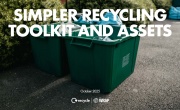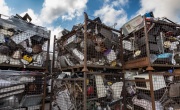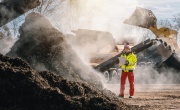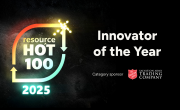Smart streets: How the Internet of Things is revolutionising waste
The urban environment is getting more sentient, changing how we go about our daily lives. Edward Perchard plugs in to the smart city scene to learn how the digital revolution could change the world of resources
You may have seen a smart city in the Hollywood classic Minority Report, which depicted a world where autonomous transport races around the city at precise distances; advertising and access to buildings is dictated by individual retinal identity; and crime is prevented by three psychic beings that can see the future. It all starts going a bit wrong because of the last one, but the rest makes for a nifty urban environment, and one that might not be too far off.
Across the world, half of humanity (over 3.4 billion people) lives in cities, and the UN estimates that by 2030, almost 60 per cent of the world’s population will live in urban areas. This rampant urbanisation is putting lots of pressure on water, resources, the living environment and, of course, public health, as cities take up just three per cent of the earth’s land, but account for 60-80 per cent of its energy consumption, 75 per cent of its carbon emissions and a great deal of its waste generation. That’s why the UN has made making cities more resilient and sustainable one of its Sustainable Development Goals.
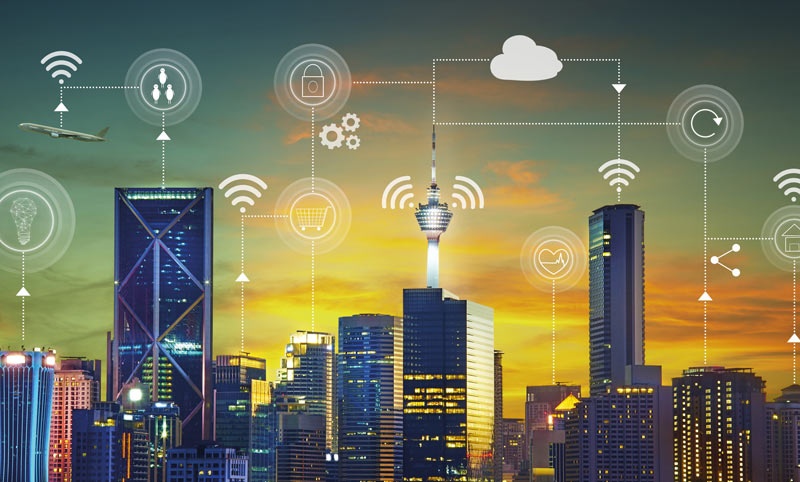
One way of doing this is using digital systems to make better use of resources. This idea of using data from citizens and sensors to create better digital, and subsequently physical, pathways – the ‘smart city’ – has gathered a lot of momentum, according to Josef Hargrave, Global Foresight Manager at engineering firm Arup, which offers advice on sustainable urban development, including the potential benefits of becoming ‘smart’.
Perhaps the easiest example of a smart city system is in the realm of transport. We are already seeing smart motorways that automatically implement variable speed limits and open hard shoulders when traffic flow is high, but sensors can also tell traffic lights when to change, while apps tell drivers what car parks are filling up and how traffic will affect their choice of routes to get where they’re going, with real-time updates on the changing flow.
All of these are made possible by the Internet of Things (IoT) – the concept of devices talking to each other, and us, to spread data and increase their functionality. The development and integration of more smart technology, says Hargrave, is “adding a digital layer to the urban fabric”, bringing untold opportunities to change how we carry out virtually every aspect of our lives.
Before we get into the potential of smarter cities and businesses, it’s worth noting what technology is actually allowing their development. Data is the key word, and that is harvested using a variety of sensors or inputs. In the waste industry, this could be through radio-frequency identification (RFID), which uses electromagnetic fields to automatically identify and track tags attached to objects, or global positioning systems (GPS) – used to track objects from satellites. As technology like this becomes cheaper, and digital pathways to recover the data are developed, that’s when things get interesting.

So, how could this change the way that waste and resources are managed? The most obvious example is your kerbside collection – a frankly inefficient process whereby the council sends the same size lorry down your street at the same time every week to pick up the bins, despite having no real idea of whether they actually need emptying. At the moment, these rounds are determined by what’s gone before, but Sam Reeve, CEO of consultancy Resource Futures, suggests that data could be used to meet demand rather than trying to predict it: “That’s started with commercial collections, but with the IoT, and if that over time evolves into smart households and connected goods within our households, that potentially leads into knowing what people are going to be disposing.”
This sort of thing is already done with street bins in some areas of the UK. Sensors in Big Belly Solar bins, for example, alert collection crews when bins are 85 per cent full to ensure that they are not allowed to overflow, but also are not emptied unnecessarily. The bins also have self- contained compactors powered by the sun to create more space, and trials with over 160 councils showed that the average frequency of bin collection dropped by 86 per cent when using the bins. Adding to the smart city fabric, each Big Belly bin can transmit a WiFi platform to showcase local council information and retailer offers. Information from the bins also allows the council to plan more effectively, showing in detail where bins are needed most.
But residential use of smart technology is progressing quickly, too. In Rotterdam, Finnish firm Enevo is partnering with the local government to increase the use of its Smart Plan software in recycling collections. Using retrofit- friendly ultrasonic sonar technology to detect fill levels in communal containers at apartment blocks, the programme provides data analytics, fill-level forecasting, dynamic route planning and driver route guidance using in-cab tablet computers to optimise collection of the city’s paper and card waste containers. The trial’s ‘proof of concept’ first stage surpassed a target to increase the efficiency of collections by 20 per cent.
The time for these new systems is very much upon us: technology consultancy Navigant Research predicted last year that the global market for smart waste collection technologies will grow from $57.6 million (£45 million) in 2016 to over $223.6 million (£178 million) in 2025. As local authorities seek to make their operations more efficient – and reduce costs – the technology presents a very appealing option. Though this smart waste fever, according to a 2013 Arup report for the government, hasn’t yet caught on in the UK, government backing for smart cities’ development could help bring it along. In the last few years, several programmes have been created to bring together government, local authorities and businesses to develop plans for the creation of smart cities. Government innovation agency Innovate UK’s Future Cities Demonstrator project gave Glasgow £24 million to develop a city management system, and London, Bristol and Peterborough £3 million each to take projects forward, as well as providing 30 councils £50,000 each to carry out feasibility studies.

In Bristol, for example, a system of ducts built beneath the city at the turn of the millennium for cable television (remember that?) is being reclaimed to connect council services and create a data-sharing network linked to a supercomputer at the University of Bristol. Bristol is Open, a partnership between the university and Bristol City Council, is now researching how this network of data can be used to harness a ‘mesh’ of devices to make the city run more smoothly. Smart waste management is among the items on the to-do list for the project’s research.
On a European level, the European Commission launched the European Innovation Partnership on Smart Cities and Communities in 2012 to help ‘overcome bottlenecks impeding the changeover to smart cities’ and co-fund demonstration projects. The GrowSmarter initiative, a €25-million Horizon 2020 project, is just one looking at the field, attempting to test 12 flagship solutions for a smart, sustainable Europe. As part of a pilot to reduce energy, greenhouse gas emissions and transport emissions by 60 per cent, underground waste system producer Envac is being retrofitted into 300 Stockholm apartments to collect food, paper, other dry recyclables and general waste. The installation will see Envac’s stationary system integrate with its optical sorting technology, sending waste through underground tubes to one container and one inlet for collection, reducing the need for waste collection trips around built-up developments altogether.
But, as Hargrave says, the smart city concept isn’t one- size-fits-all: “It’s multi-dimensional and context-dependent, both from a policy perspective and a city management perspective. In some cases it’s really top down, you might have [someone] who manages city-wide programmes, investments and research, and in some it’s much more bottom up, where the city encourages an ecosystem to evolve around it and follows a set of principles.”

In the bottom-up mould, it is often the industry that spots the potential of a market, and the waste collection giants are already circling: in January, European firm SUEZ Environnement announced a strategic partnership with cloud-based waste and recycling company Rubicon Global – the ‘Uber of trash’. The company’s software matches small waste collectors and producers on an ad hoc basis and SUEZ has bought into the US-based company to advance the digital transformation of its collection operations by improving its customer portal and digital platforms to optimise collection of small, dispersed batches of waste. The link-up will also seek to improve services for local authorities through smart city innovation, and by using data collection and analysis to help councils improve their services and optimise their fleets.
So, more connected smart cities could help make waste collections more efficient, but it could go even further than perfecting pick-ups: what, asks Reeve, if the data was more granular (i.e. broken down into more fields)? “Not just how much but what, so that the supply chain post-pickup is then also aware of what’s coming downstream to them based on what households and businesses are going to be disposing.” The technology has the potential to improve how the whole resource management supply chain operates, and the markets for materials that stem from it.
“At the moment, all the data we have is point-of-sale or point-of-use, and then everything falls into a black hole”, Reeve explains. “IoT is a game changer: it’s understanding how things are being used, what options that opens up for picking them up, and whether they can be reprocessed or reused. It’s not just about recycling, it’s about waste prevention and minimisation.” That means that, in addition to looking at the waste being created, more detailed knowledge about resource habits could enable more focused communications, from both government and businesses, about how to make the most of products. “If we’re talking about IoT and smart households and even more connectivity in our pockets through smart phones, then at the moment we’re at the tip of the iceberg. That ability to communicate directly with relevant messages for individuals and businesses based on what they are consuming and using is something that we’re only really starting to think about as a sector.”

As well as working on city and district scales, the smart revolution is taking root in our homes. Leading tech companies are already using devices to make our lives easier and to gather data for their own use. These smart innovations are changing the way we consume products, and therefore how we produce waste. Amazon, not often considered a poster child for responsible consumption, has launched a portable ‘Dash Button’ that can be assigned to a household product like washing powder and instantly orders a new batch whenever pressed. In the long-term, the shopping behemoth wants to deliver items immediately from floating warehouses using automated drones – a terrifying thought, and one that will undoubtedly have huge ramifications on waste (if it ever gets off the ground).
There’s also the issue of security. More data being generated about people’s habits might provide a better service for them, but is it secure? “I think data security will continue to be a massive issue for us, both at the corporate and public scale”, admits Hargrave. “It’s something that naturally comes with a risk; there is no escaping that.” The day that I speak to Hargrave, the hacking of over one billion Yahoo accounts is discovered – the biggest data breach in history. “If a leading IT company like Yahoo can’t look after their data properly, then we can pretty much assume that in reality we have to be aware that data and misuse of data will continue to play a key role, and companies will have to develop new capabilities to deal with that.
 This article was taken from Issue 87
This article was taken from Issue 87“In certain aspects, infrastructure systems will become more vulnerable as they get more and more connected, and in some cases they might have to be on separate networks to minimise some of those risks, or to have some redundancies built into them which go beyond digital systems... [W]e always have to weigh up the benefits and risks with all of these technology advances. It’s up to us to make an informed decision and make the right choice in terms of what brings the most benefits.”
Would security concerns stop people from buying in to smarter systems? We already see certain papers wailing about ‘bin spies’ when councils seek to make sure recycling is being carried out correctly, with one column referring to such practices as ‘an authoritarian mix of state intrusion and race-fixated social engineering’. And while technology such as RFID tags on household bins has seen some acceptance as part of weight-based reward schemes, what would the reaction be to their use, as seen in Seoul and elsewhere, as part of pay-as-you-throw systems? Reeve says that the public’s worries should always be considered and that transparency is key: “It’s about understanding and communicating what is being done and, more importantly, why it’s being done. This is not an exercise in the vast majority of instances of it being done for a penalty reason, or telling people what to buy, eat or wear, it is trying to have a better understanding of what is in the waste stream so it can be managed better.”
The urban environment is increasingly like a futuristic movie, and the movement towards smarter urban and commercial systems seems to be an unstoppable one, even if the public aren’t yet aware of it. All we have to hope for now is that Tom Cruise doesn’t get involved. 


